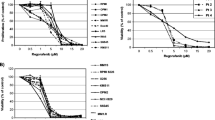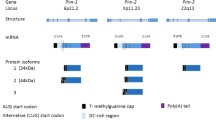Abstract
Purpose
Multiple reports point to an important role for the phosphoinositide-3 kinase (PI3K) and AKT signaling pathways in tumor survival and chemoresistance in multiple myeloma (MM). The goals of our study were: (1) to generate the preclinical results necessary to justify a Phase I clinical trial of SF1126 in hematopoietic malignancies including MM and (2) to begin combining pan-PI3K inhibitors with other agents to augment antitumor activity of this class of agent in preparation for combination therapy in Phase I/II trials.
Methods
We determined the in vitro activity of SF1126 with 16 human MM cell lines. In vivo tumor growth suppression was determined with human myeloma (MM.1R) xenografts in athymic mice. In addition, we provide evidence that SF1126 has pharmacodynamic activity in the treatment of patients with MM.
Results
SF1126 was cytotoxic to all tested MM lines, and potency was augmented by the addition of bortezomib. SF1126 affected MM.1R cell line signaling in vitro, inhibiting phospho-AKT, phospho-ERK, and the hypoxic stabilization of HIF1α. Tumor growth was 94 % inhibited, with a marked decrease in both cellular proliferation (PCNA immunostaining) and angiogenesis (tumor microvessel density via CD31 immunostaining). Our clinical results demonstrate pharmacodynamic knockdown of p-AKT in primary patient-derived MM tumor cells in vivo.
Conclusions
Our results establish three important points: (1) SF1126, a pan-PI3K inhibitor has potent antitumor activity against MM in vitro and in vivo, (2) SF1126 displays augmented antimyeloma activity when combined with proteasome inhibitor, bortezomib/Velcade®, and (3) SF1126 blocks the IGF-1-induced activation of AKT in primary MM tumor cells isolated from SF1126-treated patients The results support the ongoing early Phase I clinical trial in MM and suggest a future Phase I trial in combination with bortezomib in hematopoietic malignancies.








Similar content being viewed by others
References
Bandi P, Blount L, Boone M, Books D, Calle J, Chen A, Cokkinides V, Conner E, Dahl J, Doroshenck M, Doyle C, Gansler T, Glynn T, Heier EJ, Jacobs E, Jorenson D, Kirch R, Klevan W, Laurie D, McGinnis L, Murray T, Noel D, Rodriguez C, Saslow D, Schmidt C, Shafey O, DeSantis C, Smith R, Stefanek M, Summers S, Teschendorf B, Wang S, Weinstock M, Yates J (2007) Cancer facts and figures 2007. American Cancer Society, Atlanta
Laubach J, Richardson P, Anderson K (2011) Multiple myeloma. Annu Rev Med 62:249–264
Ikeda H, Hideshima T, Fulciniti M, Perrone G, Miura N, Yasui H, Okawa Y, Kiziltepe T, Santo L, Vallet S et al (2010) PI3K/p110{delta} is a novel therapeutic target in multiple myeloma. Blood 116:1460–1468
Mitsiades CS, Mitsiades NS, McMullan CJ, Poulaki V, Shringarpure R, Akiyama M, Hideshima T, Chauhan D, Joseph M, Libermann TA et al (2004) Inhibition of the insulin-like growth factor receptor-1 tyrosine kinase activity as a therapeutic strategy for multiple myeloma, other hematologic malignancies, and solid tumors. Cancer Cell 5:221–230
Ishikawa H, Tsuyama N, Obata M, Kawano M (2006) Mitogenic signals initiated via interleukin-6 receptor complexes in cooperation with other transmembrane molecules in myelomas. J Clin Exp Hematop 46:55–66
Manser E, Leung T, Salihuddin H, Zhao ZS, Lim L (1994) A brain serine/threonine protein kinase activated by Cdc42 and Rac1. Nature 367:40–46
Federica C, Antonio P, Guido T, Mario B (2006) Targeting signaling pathways in multiple myeloma. Curr Pharm Biotechnol 7:407–413
Ge NL, Rudikoff S (2000) Expression of PTEN in PTEN-deficient multiple myeloma cells abolishes tumor growth in vivo. Oncogene 19:4091–4095
Hideshima T, Catley L, Yasui H, Ishitsuka K, Raje N, Mitsiades C, Podar K, Munshi NC, Chauhan D, Richardson PG et al (2006) Perifosine, an oral bioactive novel alkylphospholipid, inhibits Akt and induces in vitro and in vivo cytotoxicity in human multiple myeloma cells. Blood 107:4053–4062
Pene F, Claessens YE, Muller O, Viguie F, Mayeux P, Dreyfus F, Lacombe C, Bouscary D (2002) Role of the phosphatidylinositol 3-kinase/Akt and mTOR/P70S6-kinase pathways in the proliferation and apoptosis in multiple myeloma. Oncogene 21:6587–6597
Witzig TE, Kaufmann SH (2006) Inhibition of the phosphatidylinositol 3-kinase/mammalian target of rapamycin pathway in hematologic malignancies. Curr Treat Options Oncol 7:285–294
Younes H, Leleu X, Hatjiharissi E, Moreau AS, Hideshima T, Richardson P, Anderson KC, Ghobrial IM (2007) Targeting the phosphatidylinositol 3-kinase pathway in multiple myeloma. Clin Cancer Res 13:3771–3775
Camps M, Ruckle T, Ji H, Ardissone V, Rintelen F, Shaw J, Ferrandi C, Chabert C, Gillieron C, Francon B et al (2005) Blockade of PI3Kgamma suppresses joint inflammation and damage in mouse models of rheumatoid arthritis. Nat Med 11:936–943
Hayakawa M, Kaizawa H, Moritomo H, Koizumi T, Ohishi T, Okada M, Ohta M, Tsukamoto S, Parker P, Workman P et al (2006) Synthesis and biological evaluation of 4-morpholino-2-phenylquinazolines and related derivatives as novel PI3 Kinase p110alpha inhibitors. Bioorg Med Chem 14:6847–6858
Workman P (2001) Pharmacokinetics and chemistry of LY294002. Proceeding of the 80th Meeting of American Association for Cancer Research (AACR) 88:105
Garlich JR, De P, Dey N, Su JD, Peng X, Miller A, Murali R, Lu Y, Mills GB, Kundra V et al (2008) A vascular targeted pan phosphoinositide 3-kinase inhibitor prodrug, SF1126, with antitumor and antiangiogenic activity. Cancer Res 68:206–215
Mahadevan D, Chiorean EG, Harris WB, Von Hoff DD, Stejskal-Barnett A, Qi W, Anthony SP, Younger AE, Rensvold DM, Cordova F et al (2012) Phase I pharmacokinetic and pharmacodynamic study of the pan-PI3K/mTORC vascular targeted pro-drug SF1126 in patients with advanced solid tumours and B-cell malignancies. Eur J Cancer 48:3319–3327
Field-Smith A, Morgan GJ, Davies FE (2006) Bortezomib (Velcadetrade mark) in the treatment of Multiple Myeloma. Ther Clin Risk Manag 2:271–279
Gills JJ, Dennis PA (2009) Perifosine: update on a novel Akt inhibitor. Curr Oncol Rep 11:102–110
Richardson PG, Wolf J, Jakubowiak A, Zonder J, Lonial S, Irwin D, Densmore J, Krishnan A, Raje N, Bar M et al (2011) Perifosine plus bortezomib and dexamethasone in patients with relapsed/refractory multiple myeloma previously treated with bortezomib: results of a multicenter phase I/II trial. J Clin Oncol 29:4243–4249
Holmes D (2011) PI3K pathway inhibitors approach junction. Nat Rev Drug Discov 10:563–564
Chow S, Hedley D, Grom P, Magari R, Jacobberger JW, Shankey TV (2005) Whole blood fixation and permeabilization protocol with red blood cell lysis for flow cytometry of intracellular phosphorylated epitopes in leukocyte subpopulations. Cytometry A 67:4–17
Hideshima T, Richardson P, Chauhan D, Palombella VJ, Elliott PJ, Adams J, Anderson KC (2001) The proteasome inhibitor PS-341 inhibits growth, induces apoptosis, and overcomes drug resistance in human multiple myeloma cells. Cancer Res 61:3071–3076
Hideshima T, Nakamura N, Chauhan D, Anderson KC (2001) Biologic sequelae of interleukin-6 induced PI3-K/Akt signaling in multiple myeloma. Oncogene 20:5991–6000
Martinez-Sanchez G, Giuliani A (2007) Cellular redox status regulates hypoxia inducible factor-1 activity. Role in tumour development. J Exp Clin Cancer Res 26:39–50
Vaupel P, Mayer A (2007) Hypoxia in cancer: significance and impact on clinical outcome. Cancer Metastasis Rev 26:225–239
Zeng L, Kizaka-Kondoh S, Itasaka S, Xie X, Inoue M, Tanimoto K, Shibuya K, Hiraoka M (2007) Hypoxia inducible factor-1 influences sensitivity to paclitaxel of human lung cancer cell lines under normoxic conditions. Cancer Sci 98:1394–1401
Harada H, Kizaka-Kondoh S, Li G, Itasaka S, Shibuya K, Inoue M, Hiraoka M (2007) Significance of HIF-1-active cells in angiogenesis and radioresistance. Oncogene 26(54):7509–7516
Hideshima T, Catley L, Raje N, Chauhan D, Podar K, Mitsiades C, Tai YT, Vallet S, Kiziltepe T, Ocio E et al (2007) Inhibition of Akt induces significant downregulation of survivin and cytotoxicity in human multiple myeloma cells. Br J Haematol 138:783–791
Chang H, Qi XY, Claudio J, Zhuang L, Patterson B, Stewart AK (2006) Analysis of PTEN deletions and mutations in multiple myeloma. Leuk Res 30:262–265
Jackson RC (2012) Pharmacodynamic modelling of biomarker data in oncology. ISRN Pharmacol 2012:590626
Yang M, Huang J, Pan HZ, Jin J (2008) Triptolide overcomes dexamethasone resistance and enhanced PS-341-induced apoptosis via PI3K/Akt/NF-kappaB pathways in human multiple myeloma cells. Int J Mol Med 22:489–496
Chauhan D, Pandey P, Hideshima T, Treon S, Raje N, Davies FE, Shima Y, Tai YT, Rosen S, Avraham S et al (2000) SHP2 mediates the protective effect of interleukin-6 against dexamethasone-induced apoptosis in multiple myeloma cells. J Biol Chem 275:27845–27850
Serra V, Scaltriti M, Prudkin L, Eichhorn PJ, Ibrahim YH, Chandarlapaty S, Markman B, Rodriguez O, Guzman M, Rodriguez S et al (2011) PI3K inhibition results in enhanced HER signaling and acquired ERK dependency in HER2-overexpressing breast cancer. Oncogene 30:2547–2557
Rajkumar SV, Leong T, Roche PC, Fonseca R, Dispenzieri A, Lacy MQ, Lust JA, Witzig TE, Kyle RA, Gertz MA et al (2000) Prognostic value of bone marrow angiogenesis in multiple myeloma. Clin Cancer Res 6:3111–3116
Su JD, Mayo LD, Donner DB, Durden DL (2003) PTEN and phosphatidylinositol 3′-kinase inhibitors up-regulate p53 and block tumor-induced angiogenesis: evidence for an effect on the tumor and endothelial compartment. Cancer Res 63:3585–3592
Huang J, Kontos CD (2002) PTEN modulates vascular endothelial growth factor-mediated signaling and angiogenic effects. J Biol Chem 277:10760–10766
Mayo LD, Dixon JE, Durden DL, Tonks NK, Donner DB (2002) PTEN protects p53 from Mdm2 and sensitizes cancer cells to chemotherapy. J Biol Chem 277:5484–5489
Jiang BH, Liu LZ (2009) PI3K/PTEN signaling in angiogenesis and tumorigenesis. Adv Cancer Res 102:19–65
Li J, Li F, Wang H, Wang X, Jiang Y, Li D (2012) Wortmannin reduces metastasis and angiogenesis of human breast cancer cells via nuclear factor-kappaB-dependent matrix metalloproteinase-9 and interleukin-8 pathways. J Int Med Res 40:867–876
Podar K, Tonon G, Sattler M, Tai YT, Legouill S, Yasui H, Ishitsuka K, Kumar S, Kumar R, Pandite LN et al (2006) The small-molecule VEGF receptor inhibitor pazopanib (GW786034B) targets both tumor and endothelial cells in multiple myeloma. Proc Natl Acad Sci USA 103:19478–19483
Jiang BH, Jiang G, Zheng JZ, Lu Z, Hunter T, Vogt PK (2001) Phosphatidylinositol 3-kinase signaling controls levels of hypoxia-inducible factor 1. Cell Growth Differ 12:363–369
Li W, Petrimpol M, Molle KD, Hall MN, Battegay EJ, Humar R (2007) Hypoxia-induced endothelial proliferation requires both mTORC1 and mTORC2. Circ Res 100:79–87
Chipuk JE, Green DR (2006) Dissecting p53-dependent apoptosis. Cell Death Differ 13:994–1002
Acknowledgments
We acknowledge the excellent technical assistance of Chenghu Prince. We acknowledge all of the dedicated people at Semafore Pharmaceuticals, SignalRx pharmaceuticals and the Durden laboratory for their commitment to bringing the first pan-isoform PI3K inhibitor into myeloma care. Funding for this work was by The Multiple Myeloma Research Committee to Donald L. Durden and grant CA94233 to D. L. Durden from the National Institutes of Health, the Georgia Cancer Coalition and the Aflac Cancer Center.
Conflict of interest
Dr. Durden discloses financial conflict of interest in Semafore and SignalRx Pharmaceuticals and in the SF1126 drug. The relationship between Dr. Durden and SignalRx has been internally reviewed and approved by the University of California, San Diego in accordance with its conflict of interest policies.
Author information
Authors and Affiliations
Corresponding author
Rights and permissions
About this article
Cite this article
De, P., Dey, N., Terakedis, B. et al. An integrin-targeted, pan-isoform, phosphoinositide-3 kinase inhibitor, SF1126, has activity against multiple myeloma in vivo. Cancer Chemother Pharmacol 71, 867–881 (2013). https://doi.org/10.1007/s00280-013-2078-0
Received:
Accepted:
Published:
Issue Date:
DOI: https://doi.org/10.1007/s00280-013-2078-0




